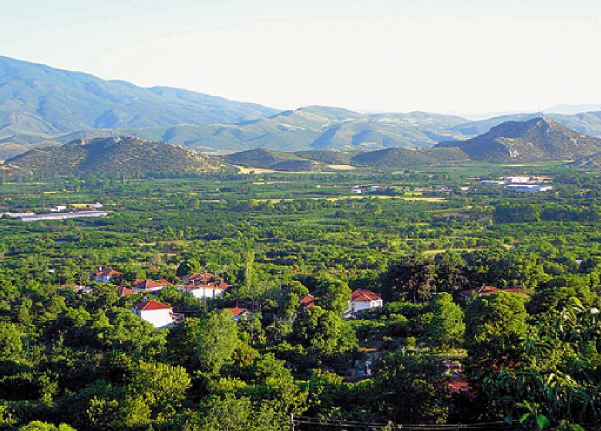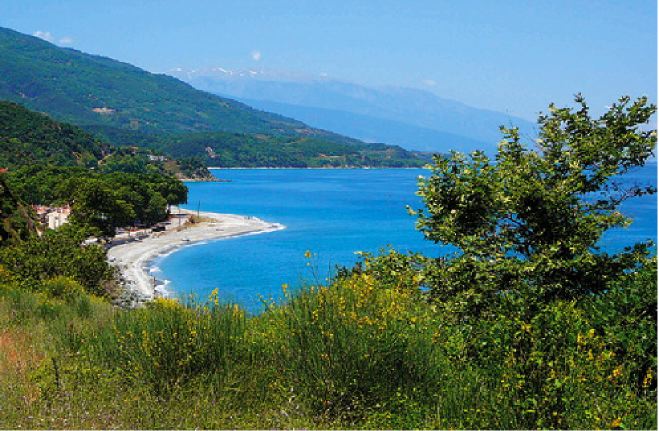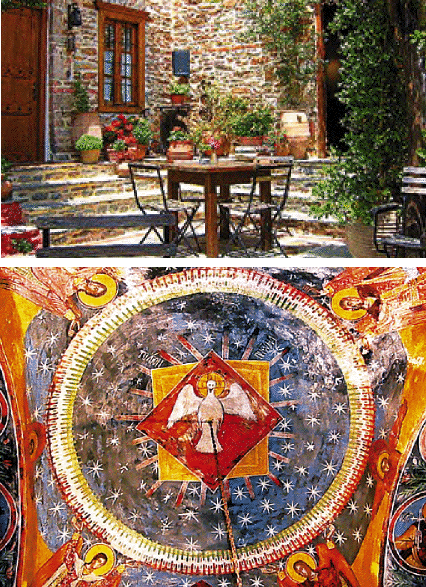 |
||
|
Kissavos - the Fruitful Mountain |
||
|
A Garden of Eden for fruit-growers, Kissavos is a rough diamond waiting to be discovered by tourists DIANA FARR LOUIS SURELY you remember from your grade-school mythology the story about the two evil giants who tried to pile Pelio on Ossa so they could reach Olympus. Otus and Ephialtes wanted to topple the gods and rape the goddesses (something our teacher never mentioned). The myth gives us the location of Mt Ossa. But even that is hard to pinpoint since, sometime between then and now, its name changed to Kissavos, so you don't see "Ossa" on many maps. With neither deities or centaurs to make it famous, Ossa/Kissavos disappeared from view. Drivers between Athens and Thessaloniki rarely give it a second thought as they skirt the great plain of Thessaly and thread their way through the poetic but treacherous Vale of Tempe (Tembi in Modern Greek) at its foot. Few suspect its beauty or its riches. Yet Kissavos is a rough diamond waiting to be discovered. |
 A panoramic view of the Agia orchards and plain |
|
|
By tourists, that is. Fruit-growers already know that it's a Garden of Eden. The gentle slopes around Agia, its only town, must have more orchards than anywhere else in Greece. In May-June they give us cherries, followed by peaches, pears and kiwis. Almonds, hazelnuts, olives and chestnuts also grow in profusion, but dwarfing them all is the apple crop: 50,000 tonnes of apples roll off Agia's trees into our markets every year. This means that Agia and the villages around it have not had to look to outsiders for their living. |
||
Naturally, fortune did not always smile upon them. There were upsets, like the blockades during the Napoleonic Wars that curtailed trade with or competition from the textile mills of the English Midlands. There were also rebellions and repression after southern Greece won its independence (Thessaly remained Ottoman until 1881). But each time the Agiotes scrambled back, switching to leather, soap, wheat and now fruit and nuts. There is a distinct pleasure in visiting a place that has no need for visitors. Especially if you manage to stay in a hotel that makes you feel like an old friend and which is run by people with a passion for their traditions. I stumbled upon the Arhontiko Soulioti in Metaxohori by chance in 2005, at the tail end of a long trip through northern Greece. Although it had opened only four years earlier, it already had a reputation, so we stopped by for lunch. Delicious food is always uppermost in my mind, but this time I was beguiled by the whole package: the setting, the flowering terrace of a restored silkwormery |
 Palioura Beach |
|
| high above the orchards of Agia; the rustic but not too folksy decor with the accent on dark wood and grey stone; and paintings on the wall by Bost, the Greek cartoonist who had a house there. But before I had tasted a morsel or spoken to a soul, I was riveted by the hand-drawn maps hanging in the front hall. One watercolour showed the churches of Agia, all 23 of them, with their belltowers and cypress trees inked against the hillside and framed by a legend giving their names, dates and other pertinent information. A larger-scale map showed the whole south face of Kissavos and its 43 landmarks, which included a Mycenaean town, an 18th-century aqueduct, a Byzantine castle and a prehistoric acropolis, in addition to the dozens of churches. Without them, I doubt we would have given Kissavos another thought, but here was a revelation that it had more to offer than roadside cherries. |
||
The maps are the work of Haris Tzikas, the husband of Hara Soulioti, who runs the hotel, which her civil engineer brother, Theodoros, bought and restored. Although he's an organic farmer (of wheat, olives and almonds), it's clear that Haris' real passion is local history. And mapping it. On our second visit we rarely saw him without his paints and a large sheet of thick ivory-coloured paper. This time he was sketching the walks and paths between the villages. He abandoned his art to draw us a much less elaborate route around the mountain for the next day, while Hara told us where to find the kalderimi (cobbled path) to a Metaxohori landmark, the Prophitis Ilias church. After the glare of scorching Athens and the already parched plain, the village was dark and excitingly watery. Rivulets gurgled down channels along the steep streets; tall trees cast deep shadows over flagstoned courtyards. Although every house seemed to possess a green-thumbed gardener, it was obvious that no skill was needed to coax roses, hydrangeas and gardenias into glossy blooms: cheeky snapdragons were bursting from cracks in the walls, turning them to flowered hedges. The short walk up to the church brought us to a plateau with a splendid view of the Agia orchards, so thick only a few red roofs sliced through the green that stretched all the way to Mavrovouni (Black Mountain), lowish and lavender, despite the name. Of course, the church was locked but 17th-century frescoes had survived in sheltered corners of the facade. We decided it was time for a sundowner and returned to the main square. |
 The flowering terrace at Arhontiko Soulioti (On top) A fresco at the Prophitis Ilias church above Metaxohori (On the bottom) |
|
|
Like so many squares in Greek mountain villages from Pelio to the Zagorohoria, Metaxohori is canopied by huge plane trees. It was deserted but for the owners of its two establishments - a taverna that merged with a larger kafeneio. We asked for ouzo but were brought tsipouro and a dish of boiled potatoes sprinkled with oil and chopped green onions to temper the strong booze. No one serves ouzo in these parts and you won't find bottled water either. As we sat, tractors rattled by - the only traffic. There were no SUVs, not even a pickup truck, and its only shop - a tiny old-fashioned grocers, with pea-green walls and half-empty shelves stocked with mackerel tins, bottled lemon juice and loo paper - had no customers.
The next day, armed with Haris' sketch and a more official map of Kissavos, we set out to explore the mountain. Our first stop, the 13th-century monastery of Agios Panteleimon, lay just outside Agia in a broad clearing surrounded by cherry trees. Two monks, brothers, tend it and grow vegetables in the courtyard. Twenty years ago, its grey-stone buildings were being used by farmers, who even stabled their animals in the refectory. Seventy years of abandonment had left their mark, graffiti scratched into the church frescoes being the most offensive. "School kids. Christians not Turks," said Abbot Emilianos, shaking his dark beard. Leaving the monastery - "a refuge for man and nature", as Emilianos called it - we drove on to Melivia, where Haris had said there was a path that led to a waterfall and the beach of Velika. Just 30 minutes' walk. It must have been 35, for we never found it. Discouraged by the steep cemented street to the path's start, we dutifully followed arrows to benches and a wooden bridge, but there were no enlightening distance markers and we began to wilt. We paused by a stream, hovered over some orchids and retraced our steps. The occasional laden cherry tree fuelled the ascent. When we arrived back at the house where the path originated, an old couple with an almost impenetrable accent exclaimed, "What do you want to go walking now for! Come back in October when it's cool." It was May. Haris' map took us down to the sea before we could circumnavigate the mountain. The unbroken strip (30km) of beach, from Agiokambos to Stomio, is Larissa's playground and shows the same motley development and questionable taste that afflicts many provincial coasts. But you can see the long legs of Halkidiki silhouetted along the horizon and a few coves remain unspoiled. More cherry trees crowded behind the beach houses. Albanians perched in their branches, filling buckets with red fruit to the tune of 300 kilos a day. A merry one introduced himself as Clyde as he posed for a photo. At Kokkino Nero, we turned inland and ascended through amazingly lush vegetation nurtured on red earth and weblike skeins of water. Gusts of scented broom were dangerously intoxicating. Just after Karitsa, the road forked towards the summit and we plunged into dense forest. On the official map, this route - like so many others on Kissavos - is marked in green to denote scenic beauty. What an understatement. We felt as though we were tunnelling at the bottom of a canyon formed by the trunks of immense trees. The cherry orchards had long since given way to chestnuts, but now these were engulfed by beech, rowan, hazel, oak, black fir and dozens of others we could not identify. Sunbeams stippled their leaves but failed to reach the forest floor. A woodpecker drilled overhead. All too soon, the road, now passable dirt, opened onto more conventional mountain scenery - alpine pastures, conical firs, deep valleys, a fiercely ribbed series of crags to the north, and beyond them the snow-streaked peaks of Olympus. Suddenly we could see Kissavos' summit (1,976m); its bald dome bobbed above the firs like a monk's tonsure. Another fork would have taken us up to the refuge, but the views looked just fine, thank you, from this level, and the Toyota already had enough to cope with. We shouldn't have worried: the forestry service keeps the roads graded and the circuit was smooth all the way to Spilia, which must be the Kissavos' highest village. The mountain loomed above it, a giant pyramid. To get back to the purlieus of Agia, we continued south through meadowed tablelands and Christmas tree farms, trusting our instinct at signless crossroads, until we reached the village of Anatoli and the home stretch. Sated with driving and spectacular vistas, we did not give it or Megalovryso the attention Haris had said they deserved but sped back to Metaxohori and the comforts of home. That evening we met a couple who had taken the three-hour walk from Anatoli - a more respectful way to savour it, had we world enough and time. How to get there |
||
|
|
||
(Posting Date 6 June 2008) HCS readers can view other excellent articles by this writer in the News & Issues and other sections of our extensive, permanent archives at the URL http://www.helleniccomserve.com./contents.html
All articles of Athens News appearing on HCS have been reprinted with permission. |
||
|
||
|
2000 © Hellenic Communication Service, L.L.C. All Rights Reserved.
http://www.HellenicComServe.com |
||

